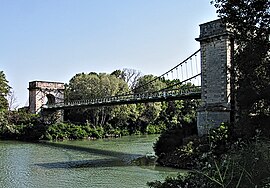Fourques, Gard
| Fourques | ||
|---|---|---|
| Commune | ||

Pont de Fourques: suspension bridge over the Petit Rhône
|
||
|
||
| Coordinates: 43°41′38″N 4°36′40″E / 43.6939°N 4.6111°ECoordinates: 43°41′38″N 4°36′40″E / 43.6939°N 4.6111°E | ||
| Country | France | |
| Region | Occitanie | |
| Department | Gard | |
| Arrondissement | Nîmes | |
| Canton | Beaucaire | |
| Intercommunality | Beaucaire-Terre d'Argence | |
| Government | ||
| • Mayor (2008–2014) | Gilles Dumas | |
| Area1 | 38.24 km2 (14.76 sq mi) | |
| Population (2008)2 | 2,888 | |
| • Density | 76/km2 (200/sq mi) | |
| Time zone | CET (UTC+1) | |
| • Summer (DST) | CEST (UTC+2) | |
| INSEE/Postal code | 30117 /30300 | |
| Elevation | 1–15 m (3.3–49.2 ft) (avg. 3 m or 9.8 ft) |
|
|
1 French Land Register data, which excludes lakes, ponds, glaciers > 1 km² (0.386 sq mi or 247 acres) and river estuaries. 2Population without double counting: residents of multiple communes (e.g., students and military personnel) only counted once. |
||
1 French Land Register data, which excludes lakes, ponds, glaciers > 1 km² (0.386 sq mi or 247 acres) and river estuaries.
Fourques (Occitan: Forcas) is a commune and a village in the southeastern corner of the Gard department in southern France, some 4 km (2.5 mi) north of Arles. The village is located at the confluence of the Rhone and the Little Rhone and sprang up adjoining a bridge across the latter built by the Romans. A historic suspension bridge was constructed across the Little Rhone early in the nineteenth century.
Fourques, meaning "fork", is located close to the Camargue delta at the point where the Little Rhone flows into the Rhone on the border between the Gard and the Bouches-du-Rhône. It is easily accessible from Autoroute A9 linking Nîmes and Montpellier. The land surrounding the village is flat and prone to flooding.
The village appears to have grown up next to the bridge which was built in the 2nd century to connect the Roman road Via Julia (Voie Julienne) to the Via Domitia at Beaucaire. Fourques Castle (Château de Fourques) is first mentioned in 1070 in an agreement involving Raymond of St Gilles. In 1180, it was besieged by the Alfonso II of Aragon while it was in the hands of Raymond of Toulouse. In 1215, the castle came into the ownership of Simon de Montfort but was returned to the Crown in 1229. The village church dates from the 15th century. Damaged during the religious wars, its roof was restored in the 16th century.
...
Wikipedia



